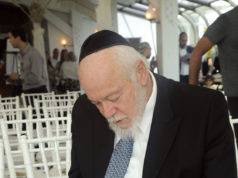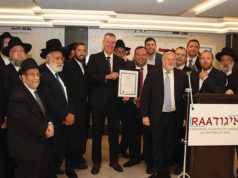
Jewish travelers arrived in Japan with Portuguese and Dutch merchants as early as the 16th century, but Jews did not permanently settle there until after Commodore Perry’s arrival in 1853. By 1895 the Jewish community developed to about 50 families and established Japan’s first synagogue.
In the 1880s, Jews settled in Nagasaki, a Japanese port city that was accessible to Jews fleeing from Russian pogroms. Soon after, the Nagasaki community, with about 100 families, was larger than the one in Yokohama. The Beth Israel Synagogue was built in 1894. During the Russo-Japanese War the Nagasaki community disintegrated, passing its Torah scroll to the Jews of Kobe. One of the most esteemed members of this group was Joseph Trumpeldor, who later became a hero of the Zionist movement for his role in the formation of the Jewish Defense Forces in Palestine.
The great earthquake of 1923 that destroyed most of Tokyo had a major effect on Jewish life. Until that time, the most active Jewish community in Japan was in Yokohama. Following the earthquake the community moved to Kobe.

During the early to middle 1900s, the Kobe community was composed largely of Jews from Russia, the Middle East and Germany. The Middle Eastern Jews, known as Baghdadi Jews, came from Iraq and Syria, Yemen, Iran, and other areas in Central Asia and the Middle East. While some emigrated for economic reasons, others responded to changing developments during the 1930s.
The Tokyo community, now Japan’s largest, was slower to develop. The Japanese capital only became an important center of Jewish life with the arrival of the American Jewish servicemen. From the postwar period to the present, small numbers of Jews regularly arrived from the United States and Western Europe for business, academic or professional reasons. The Tokyo community, where the Israeli Embassy is located, has a higher profile than Kobe.
The synagogue services in Kobe and Tokyo are a mixture of traditional and modern. The Kobe synagogue, Ohel Shelomoh, was built in 1970. An earlier synagogue was destroyed in air raids during World War II. The community conducts its services largely according to Sephardic practice, reflecting the origins of its founders, although most of the Jews attending services are usually Ashkenazim. There is no full-time resident rabbi and the size of the community probably makes it unlikely that one will be recruited. The community is very warm and welcoming. After Friday night services everyone is welcome to stay for dinner—a kosher meal prepared by a Japanese cook. Meals are also provided after morning services and just before the evening service. Usually most of those attending services remain throughout the day, only leaving after havdalah.
The Tokyo community has a full-time American rabbi. Japan’s Jewish population (excluding American armed forces personnel and diplomatic staff) is about 600, mostly in Tokyo, although the number who are active in synagogue and community affairs is fewer.
Japanese attitudes towards foreigners have oscillated wildly throughout history, from outright hostility to the most extravagant admiration. In the aftermath of the Bolshevik Revolution, the Jews of Yokohama and Kobe offered help to several thousand Jewish refugees with the cooperation of the Japanese government. Many of these refugees had been unable to land in Japan because they lacked the necessary funds. This problem was resolved with the help of Jacob Schiff, the president of the American Hebrew Immigrant Aid Society.
During WWII, Japan was one of the world’s only countries where Jews could find refuge from the Holocaust. This occurred despite Japan’s alliance with Nazi Germany. Following the German invasion of Poland, Jewish refugees were unable to board Italian or Japanese ships en route from Italy to Shanghai or Japan. With passage from the Mediterranean blocked, the only escape route east was through the Soviet Union on the Trans-Siberian Railway bound for Vladivostok. This route remained open until the German invasion of Russia in June 1941. More than 10,000 Jews, fleeing for their lives, were able to enter neutral Lithuania from Poland between October 1939 and May 1940. Among them were nearly 5,000 who successfully made their way to Japan.
These refugees were granted passage through the help of the Dutch Consul in Lithuania. The Consul offered the refugees misleading landing permits and transit visas to Curacao in the Dutch West Indies. They were also assisted by Chiune Sugihara, the first representative of the Japanese consulate in Lithuania. Sugihara ignored instructions from his own government, issuing several thousand passports with a Japanese 8-12 day transit visa. Hillel Levine’s 1996 book, In Search of Sugihara, suggests this remarkable man, motivated solely by kindness and humanity, may have saved as many as 10,000 lives. In any case, the documents he granted were sufficient to allow those fortunate enough to have them to secure exit visas from the Russian authorities. Sugihara’s heroism, recognized years later by the State of Israel (and Yad Vashem), cost him dearly with his own government. He sacrificed his career by enabling thousands of Jews to survive.
Unfortunately, the refugees lived peacefully in Japan for only three to eight months. Then, after the bombing of Pearl Harbor, half of them were able to move to the United States, Canada, and other areas in the Western Hemisphere. With no other place to turn, the remainder relocated to Japanese-occupied Shanghai. Here, too, the Japanese record proved exemplary, as the government resisted repeated requests from Nazi officials for assistance in the relocation and extermination of the Jews in the Shanghai ghetto.
Anti-Jewish activity in Japan has been minimal. There are some accounts of Jews losing jobs during World War II. On the whole, anti-Semitism is rare. Many Japanese sympathize with Jewish suffering, seeing parallels between their own wartime tragedies and those experienced by the Jews of Europe.
The Japanese attitude towards Jews, Judaism and Israel seems somewhat complex. Few Japanese residents of Tokyo or Kobe know that there are Jewish communities located in their cities. The nature of Jewish life lies outside of Japanese experience.
As elsewhere, anti-Zionism had an influence over Japanese policy-makers. Following the Six-Day War, left-wing Japanese began to sympathize with the Arabs who were perceived as the underdogs. In addition, conservative circles in government and business were concerned about the country’s access to oil. Japanese businesses were largely willing to comply with the Arab boycott. It was not until the 1990s that Japanese companies began to take an active role in the Israeli economy.
When the Tokyo synagogue, Beth David was dedicated in 1968, the motives for maintaining Jewish life in Japan were articulated in a dedication speech: “Here, in a strange land on the edge of the Diaspora, far from the world centers of Judaism, with no external, visible reminders of our heritage, a whole generation, our children, are in constant danger of being lost to our people. This is why we have a Jewish community, why we determinedly, stubbornly, even fiercely insist on a center of Jewish life in Tokyo, where we can raise our children as Jews.”
The Japanese and the Jews share much in common, as complex peoples who are among the world’s most enduring and most modern, at once traditional and innovative, respectful of the past yet zealous for the future. If any bridge is needed between them, it is surely in the example of Sugihara who helped make it possible for Jews to visit and live in Japan in warmth and with pride.
____________
Daniel Ari Kapner studied at the University of Massachusetts, specializing in Japanese and Judaic studies. Stephen Levine is a Professor at Victoria University of Wellington in New Zealand. This article was edited for space.



